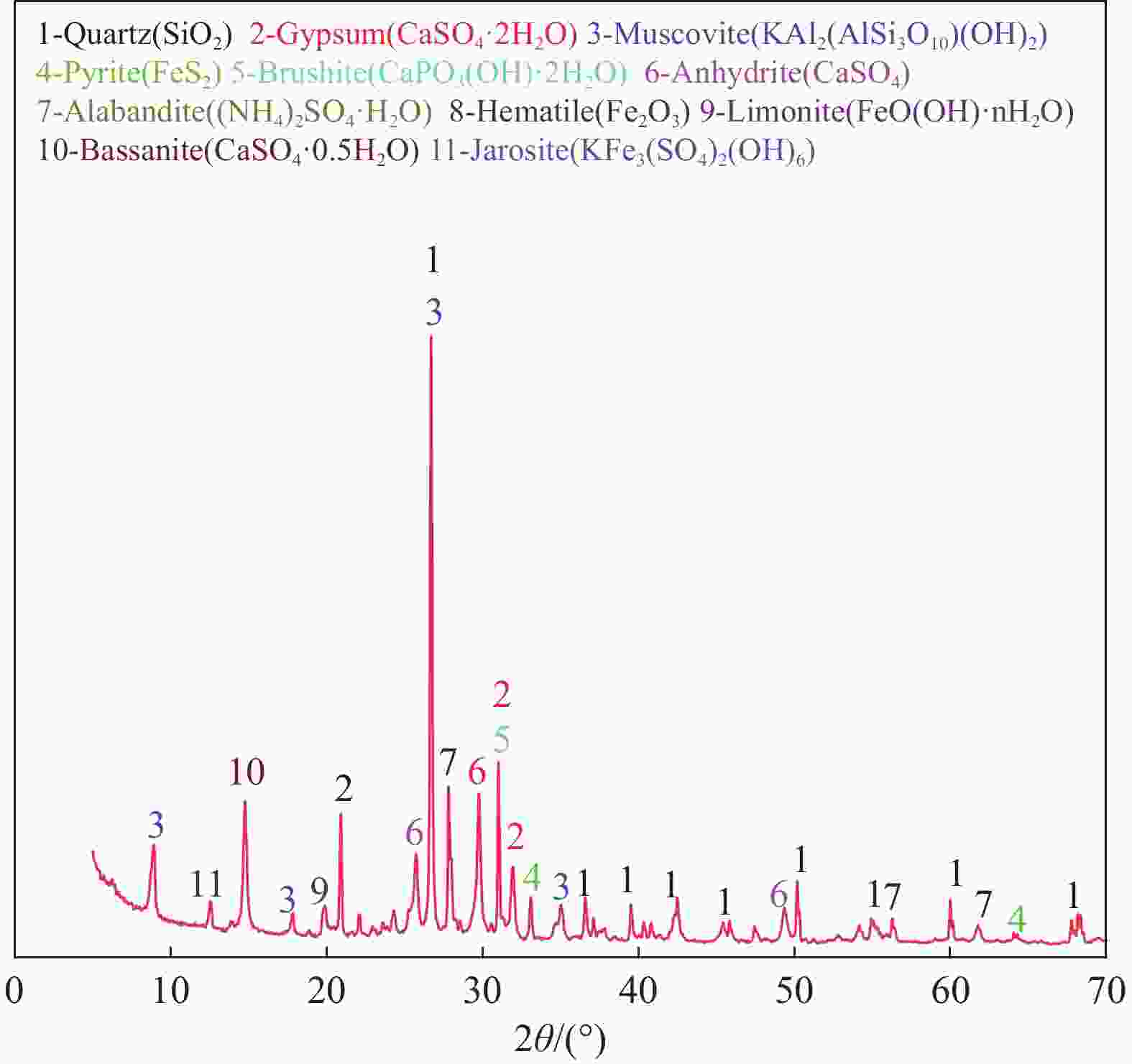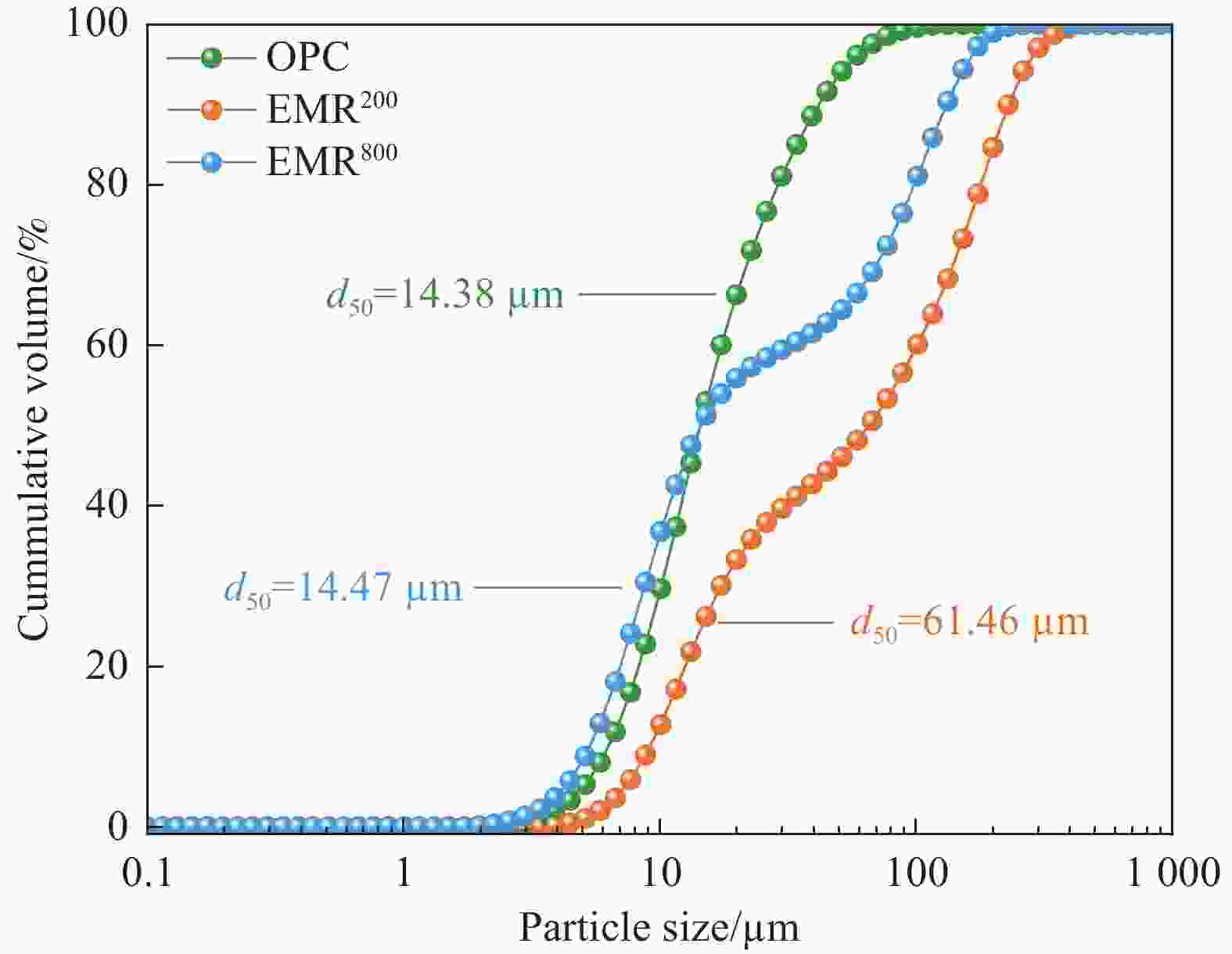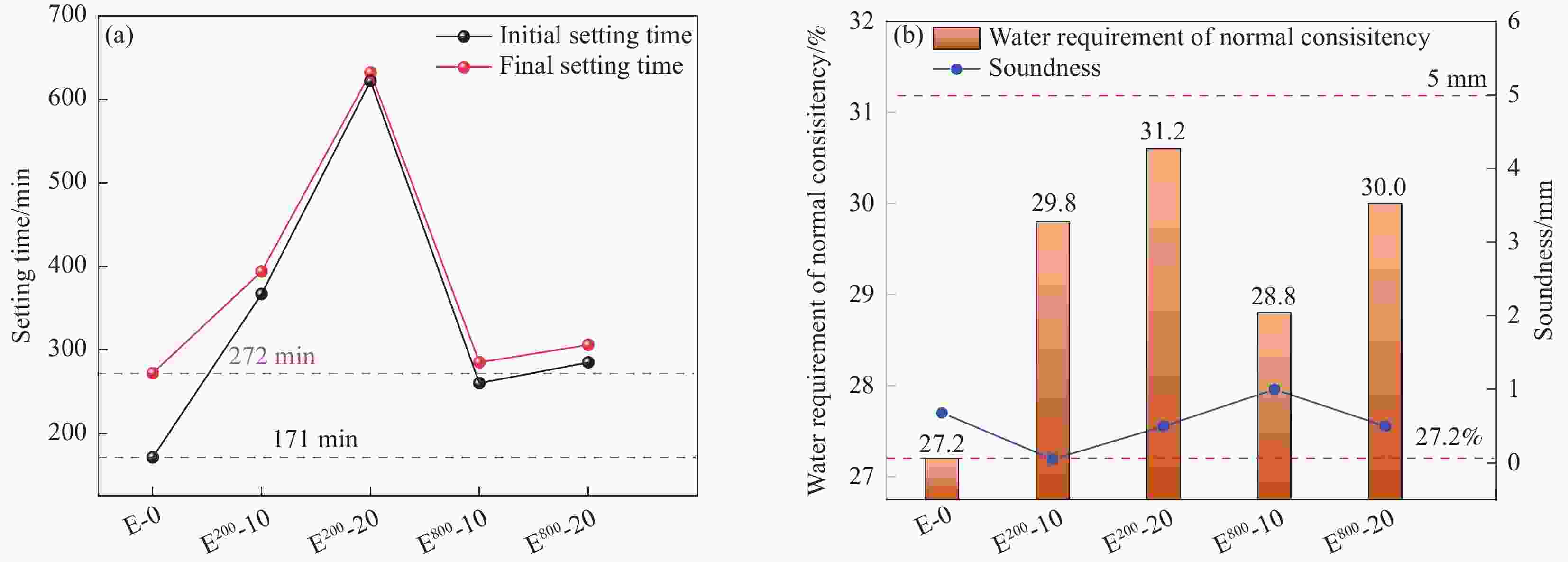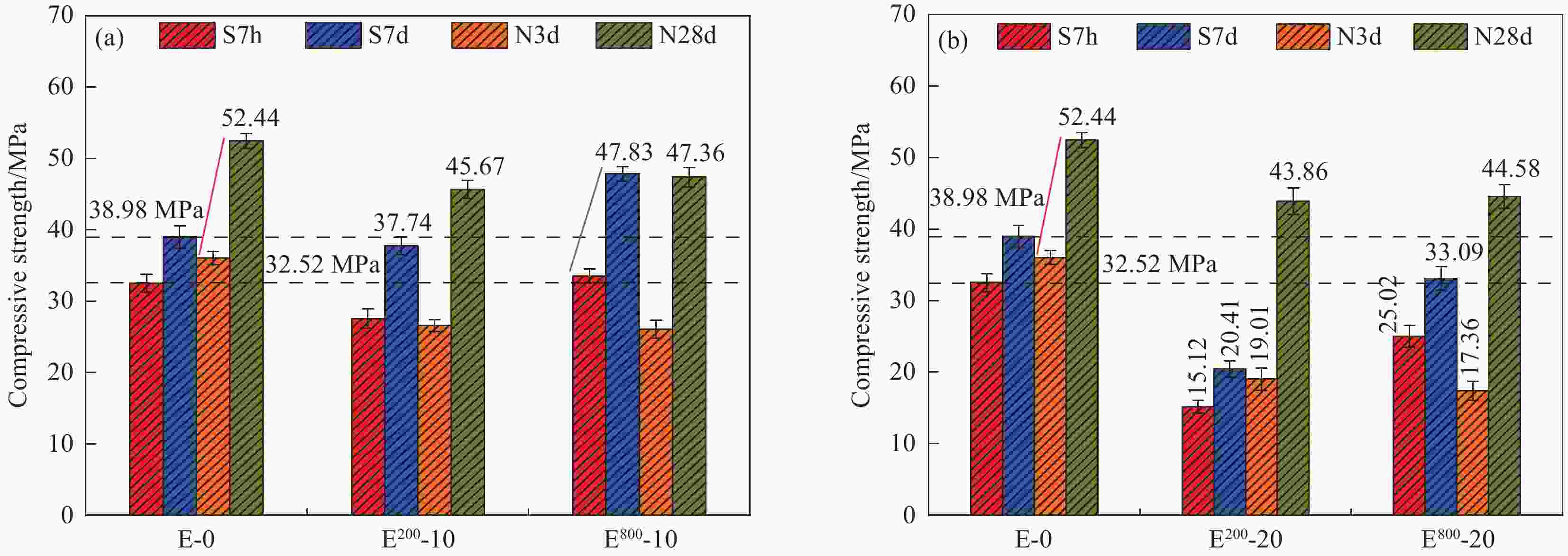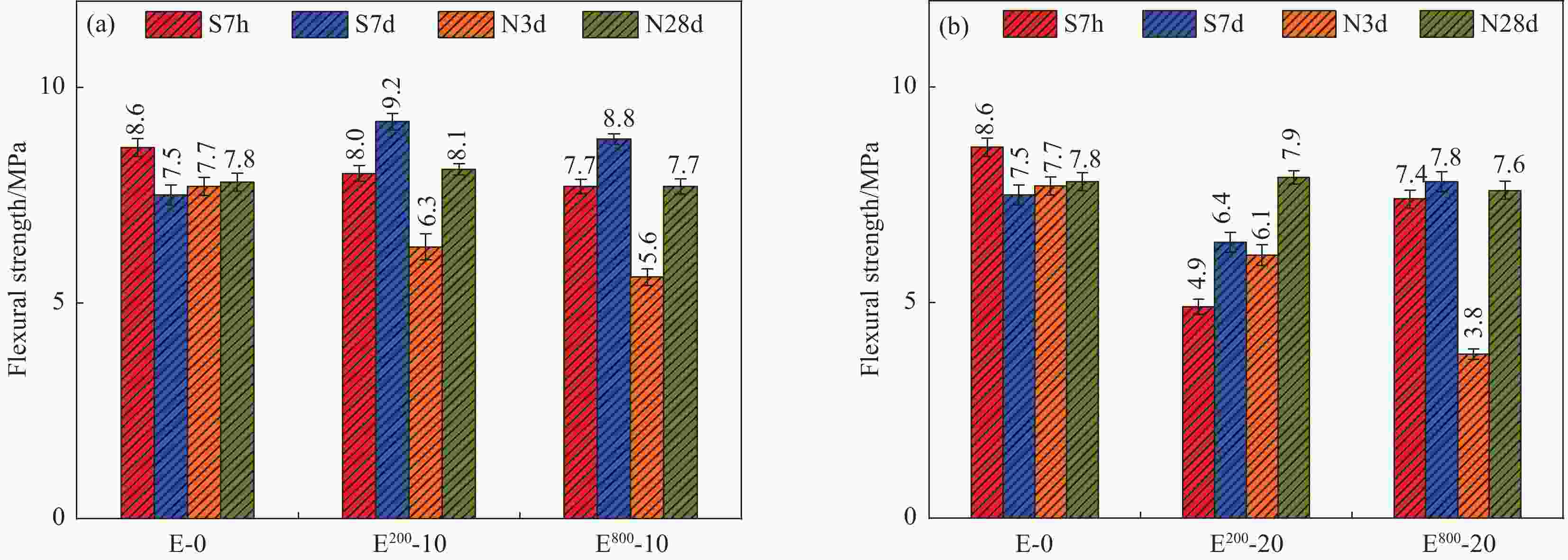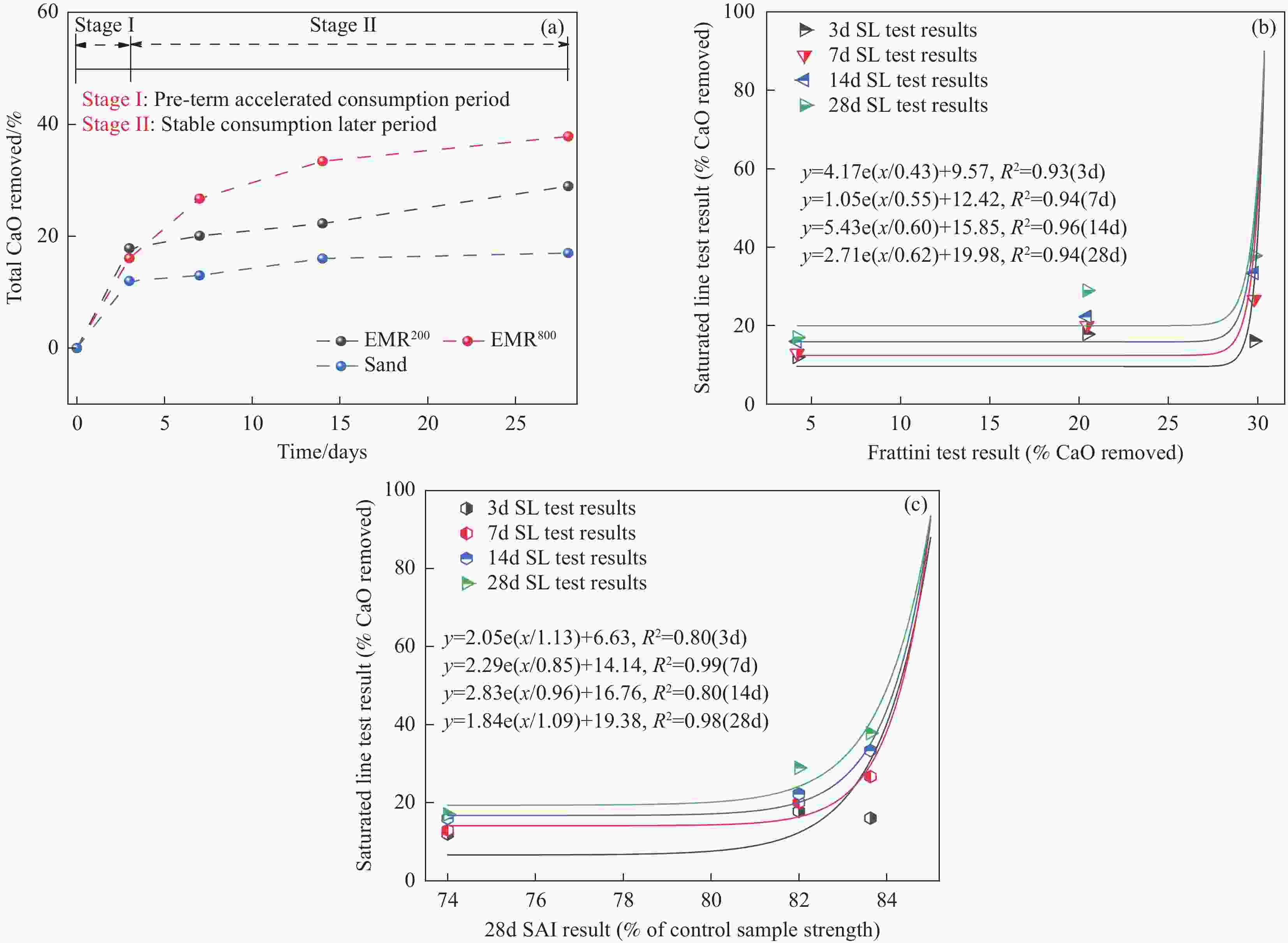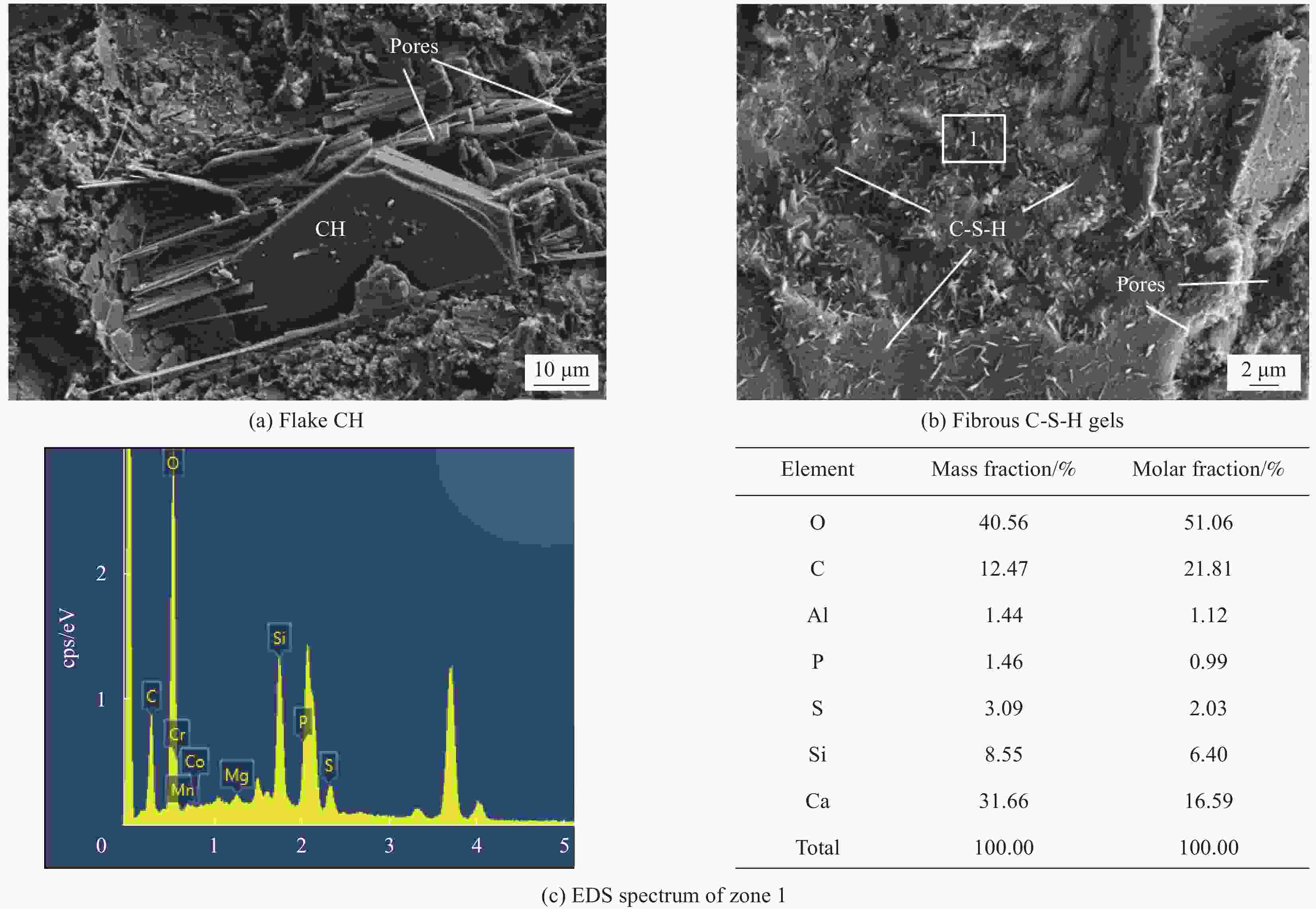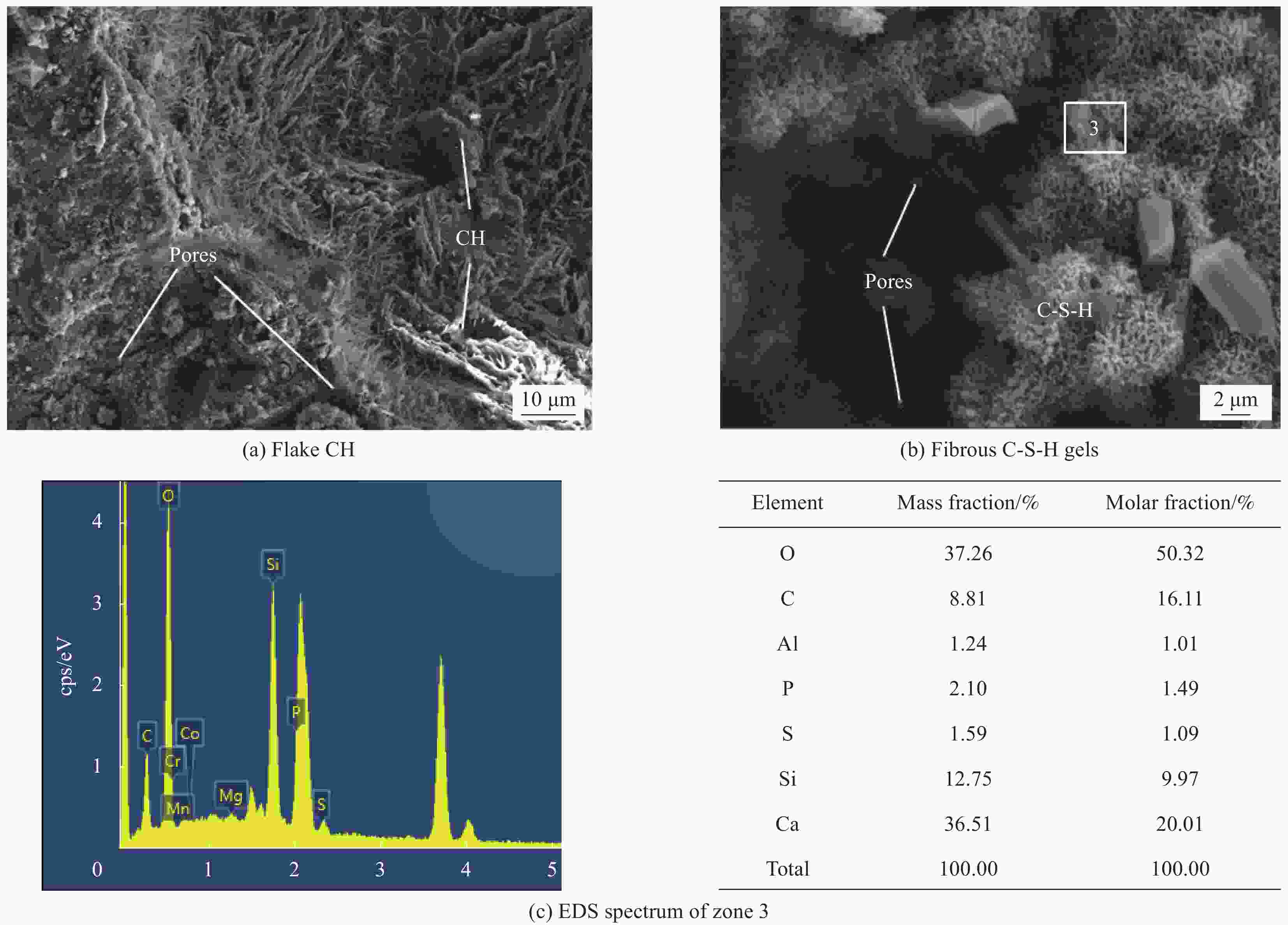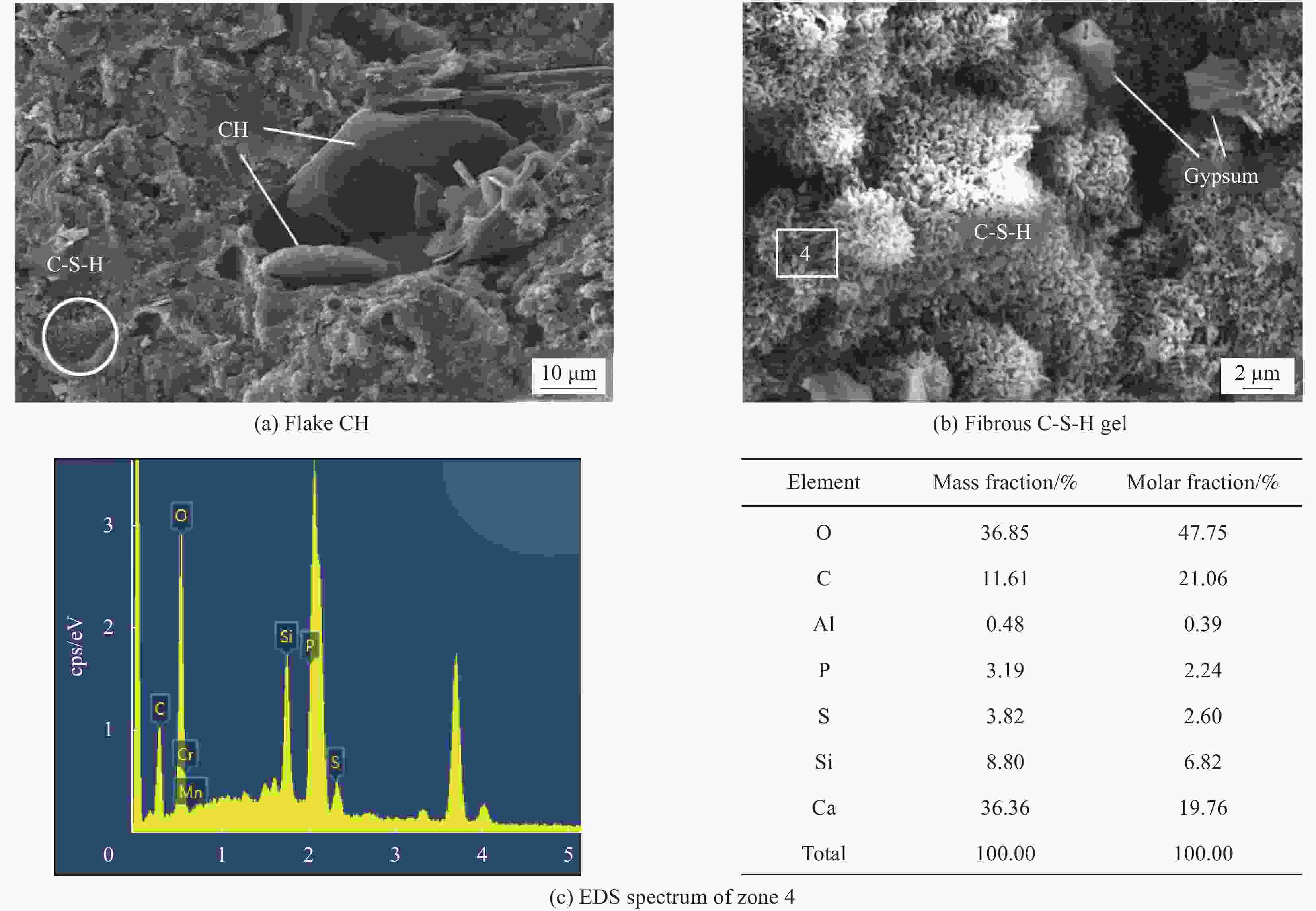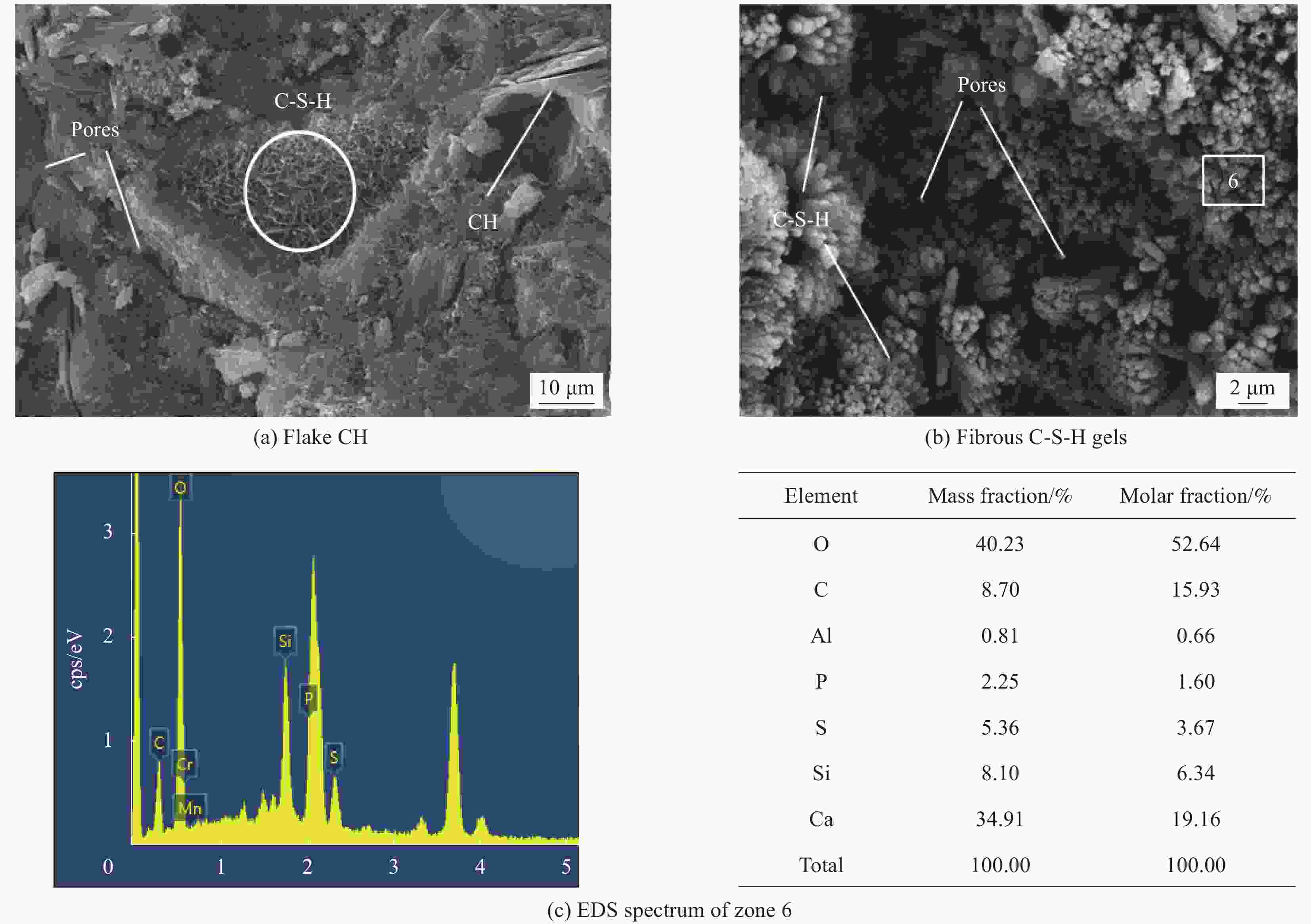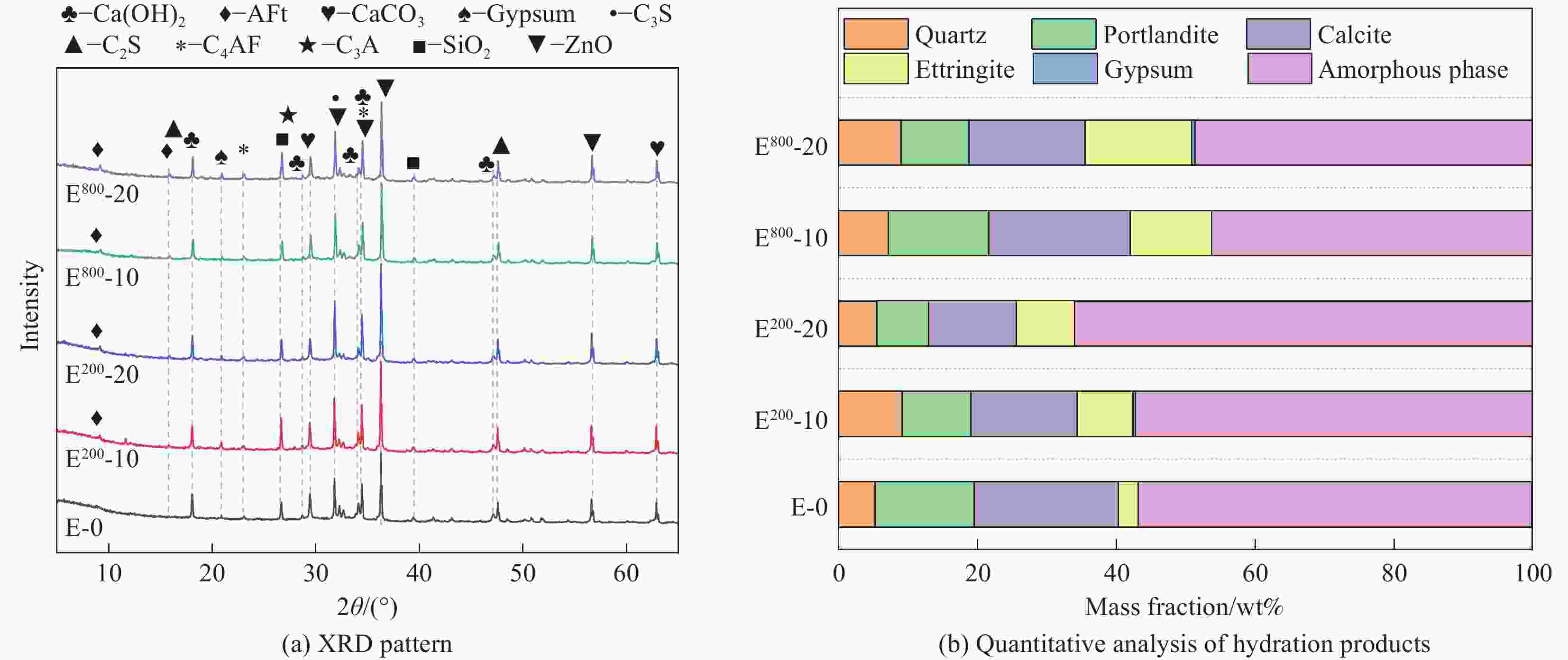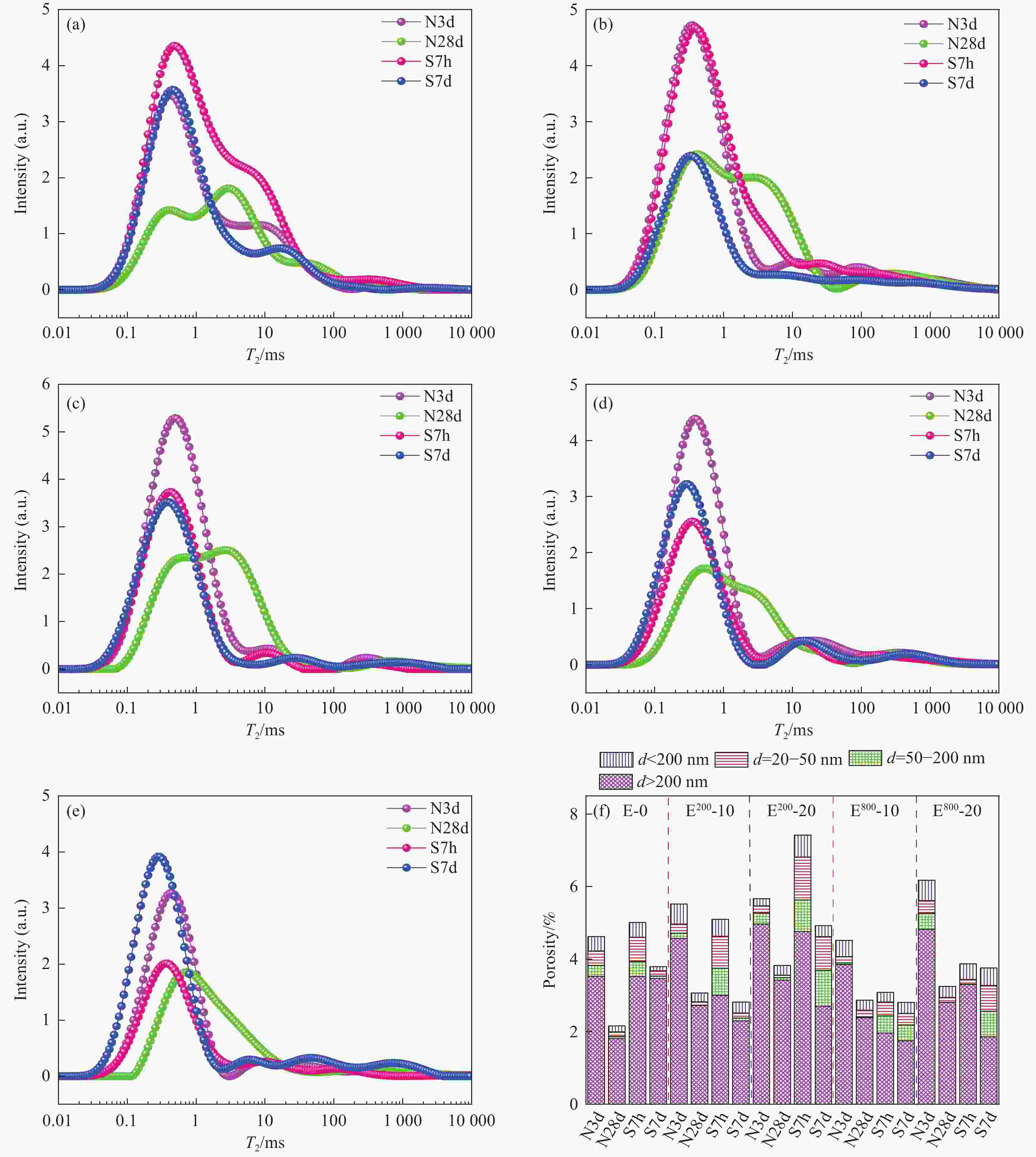Effect of steam curing conditions on mechanical properties and microstructure of electrolytic manganese residue cement mortar
-
摘要: 研究了不同煅烧温度(200℃和800℃)电解锰渣(EMR)火山灰活性及掺入0wt%、10wt%、20wt% EMR水泥胶砂在80℃蒸养7 h、7 d和标准养护3 d、28 d条件下力学性能、水化产物与孔隙特征分布。采用低场核磁共振技术、XRD定量表征及SEM微观形貌共同揭示了EMR对水泥胶砂的水化产物、孔径分布及孔隙率等影响规律,并探究了不同养护条件对EMR水泥胶砂水化进程的影响。结果表明:800℃煅烧EMR火山灰活性明显高于200℃煅烧火山灰活性,当800℃煅烧EMR替代量为10wt%时,初凝、终凝时间和标准稠度用水量分别为对照组的1.52、1.06和1.05倍,而蒸养7 h、7 d抗压强度分别高于标养3 d和28 d抗压强度,而抗折强度仅仅在蒸养7 d时高于对照组17.3%;纯水泥胶砂的水化产物主要为纤维状C-S-H和片状CH,而EMR水泥胶砂中由于硫酸盐含量较高,除了上述水化产物之外,在蒸养或标养条件下均可观察到石膏相与针棒状AFt的存在,标准养护28d时,CH、AFt和无定性含量分别为14.50%、11.75%和46.25%,与蒸养7 d衍射峰基本相似。另外,蒸养7 h与标准养护3 d对比孔隙率减少1.44%,蒸养7 d与标准养护28 d对比孔隙率减少0.06%。综上,蒸养可以提高800℃煅烧EMR火山灰活性,同时还可以加速EMR水泥胶砂的水化进程和细化其内部孔结构,进而提高了胶砂的力学性能。Abstract: The pozzolanic activity of electrolytic manganese residue (EMR) at different calcination temperatures (200℃ and 800℃), and the distribution of mechanical properties, hydration products, and pore characteristics of cement mortar with 0wt%, 10wt% and 20wt% EMR, subjected to 80℃ steam curing for 7 h and 7 d, as well as standard curing for 3 d and 28 d, were studied. The effects of EMR on the hydration products, pore size distribution and porosity of cement mortar were revealed by low field nuclear magnetic resonance technology, XRD quantitative characterization and SEM microstructure. The effects of different curing conditions on the hydration process of EMR cement mortar were also investigated. The results show that the pozzolanic activity of EMR calcined at 800℃ is significantly higher than that of EMR calcined at 200℃. When the substitution amount of EMR calcined at 800℃ is 10%, the initial setting time, final setting time and water requirement of normal consistency are 1.52, 1.06 and 1.05 times that of the control group, respectively. The compressive strength of steam-cured 7 h and 7 d is higher than that of standard-cured 3 d and 28 d, respectively, while the flexural strength is only 17.3% higher than that of the control group at 7 d. The hydration products of pure cement mortar are mainly fibrous C-S-H and sheet-like CH, while in EMR cement mortar, due to the high sulfate content, in addition to the above hydration products, the presence of gypsum phase and needle shaped AFt can be observed under steam curing or standard curing conditions. The CH, AFt and amorphous contents are 14.50%, 11.75% and 46.25% after 28 days of standard curing. These values are similar to the diffraction peaks after 7 days of steam curing. In addition, the porosity of steam-cured 7 h is 1.44% lower than that of standard curing 3 d, and the porosity of steam-cured 7 d is 0.06% lower than that of standard curing 28 d. In summary, steam curing can improve the pozzolanic activity of EMR calcined at 800℃, accelerate the hydration process, and refine the internal pore structure, thereby improving the mechanical properties of the mortar.
-
Key words:
- electrolytic manganese residue /
- pozzolanic activity /
- steam curing /
- hydration products
-
图 10 EMR200和EMR800在40℃的密封塑料瓶中养护1、3、7和28 d: (a)SL消耗试验,(b)SL消耗试验与Frattini试验相关性,(c) SL消耗试验与28 d SAI之间的相关性
Figure 10. EMR200 and EMR800 are cured in sealed plastic bottles at 40℃ for 1,3,7 and 28 days: (a)SL consumption test, (b)correlation between SL consumption test and Frattini test, (c)correlation between SL consumption test and 28 d SAI
表 1 普通硅酸盐水泥(OPC)和电解锰渣(EMR)的化学组成
Table 1. Chemical composition of ordinary portland cement (OPC) and electrolytic manganese residue (EMR)
wt% Material Al2O3 SiO2 Fe2O3 CaO SO3 MgO Other OPC 6.57 19.34 3.22 47.95 1.23 1.58 4.06 EMR200 11.85 39.72 5.92 10.07 24.47 1.22 6.75 EMR800 10.79 37.03 6.66 12.29 24.60 1.24 7.21 表 2 EMR水泥胶砂的配比与养护条件
Table 2. Proportioning and curing conditions of EMR cement mortar
Sample OPC/ g EMR/ g Sand/ g Water/ g Curing condition E-0 450 0 1350 225 80℃ steam curing for 7 h (S7 h)
80℃ steam curing for 7 d (S7 d)
Standard curing 3 d (N3 d),
Standard curing 28 d (N28 d)E200-10 405 45 1350 225 E200-20 360 90 1350 225 E800-10 405 45 1350 225 E800-20 360 90 1350 225 Notes: “E-0”indicates control specimen; E200-10, where “E200” indicates an EMR calcination temperature of 200℃, “10” indicates an EMR substitution rate of 10 %, and other similar specimens. 表 3 EMR200和EMR800在8 d时Frattini测试结果
Table 3. Frattini test results of EMR200 and EMR800 at 8 d
Material [OH] mmol/L [CaO] mmol/L Theoretical max. [CaO] mmol/L [CaO] reduction% Sand 52.8 9.68 9.25 −4.4 EMR200 58.9 6.34 7.97 20.45 EMR800 54.0 6.30 8.79 28.3 -
[1] WANG Y, GAO S, LIU X, et al. Preparation of non-sintered permeable bricks using electrolytic manganese residue: Environmental and NH3-N recovery benefits[J]. Journal of Hazardous Materials, 2019, 378: 120768. doi: 10.1016/j.jhazmat.2019.120768 [2] WANG D, WANG Q, XUE J. Reuse of hazardous electrolytic manganese residue: detailed leaching characterization and novel application as a cementitious material[J]. Resources, Conservation & Recycling, 154, 2020, 104645. [3] SHU J, CHEN M, WU H, et al. An innovative method for synergistic stabilization/solidification of Mn2+, NH4+-N, PO43− and F− in electrolytic manganese residue and phosphogypsum[J]. Journal of Hazardous Materials, 376, 2019, 212–222. [4] SHU J, LIU R, LIU Z, et al. Simultaneous removal of ammonia and manganese from electrolytic metal manganese residue leachate using phosphate salt[J]. Journal of Cleaner Production. 135, 2016, 468–475. [5] 聂霄悍, 雷学文, 刘磊等. 堆存陈化对电解锰渣重金属赋存形态及环境风险演化的影响[J/OL]. 中国环境科学: 1-102024-01-19]. NIE Xiaohan, LEI Xuewen, LIU Lei, et al. Effect of storage-aging on occurrence morphology of heavy metals and associated environmental risk evolution in electrolytic manganese residue[J/OL]. China Environmental Science: 1-10[2024-01-19] (in Chinese). [6] FU Y, QIAO H, FENG Q, et al. Self-stabilisation of high-temperature calcined electrolytic manganese residue in mortar[J]. Construction and Building Materials, 2023, 386: 131460. doi: 10.1016/j.conbuildmat.2023.131460 [7] FU Y, Qiao H, FENG Q, et al. Review of new methods for resource utilisation of electrolytic manganese residue and its application in building materials[J]. Construction and Building Materials, 2023, 401: 132901. doi: 10.1016/j.conbuildmat.2023.132901 [8] YANG C, LV X, TIAN X, et al. An investigation on the use of electrolytic manganese residue as filler in sulfur concrete[J]. Construction and Building Materials, 2014, 73: 305-310. doi: 10.1016/j.conbuildmat.2014.09.046 [9] HE D, SHU J, WANG R, et al. A critical review on approaches for electrolytic manganese residue treatment and disposal technology: reduction, pretreatment, and reuse[J]. Journal of Hazardous Materials, 2021, 418: 126235. doi: 10.1016/j.jhazmat.2021.126235 [10] DUAN N, DAN Z, WANG F, et al. Electrolytic manganese metal industry experience based China’s new model for cleaner production promotion[J]. Journal of Cleaner Production, 2011, 19: 2082-2087. doi: 10.1016/j.jclepro.2011.06.024 [11] 王继林, 龙广成, 董荣珍, 等. 掺电解锰渣砂浆的强度与微结构及碳排放分析[J]. 铁道科学与工程学报, 2023, 20(4): 1382-1391.WANG Jilin, LONG Guangcheng, DONG Rongzhen et al. Strength and microstructure of electrolytic manganese slag doped mortar and carbon emission analysis[J]. Journal of Railway Science and Engineering, 2023, 20(4): 1382-1391(in Chinese). [12] HE D, SHU J, WANG R, et al. A critical review on approaches for electrolytic manganese residue treatment and disposal technology: Reduction, pretreatment, and reuse[J]. Journal of Hazardous Materials, 2021, 418: 126235. doi: 10.1016/j.jhazmat.2021.126235 [13] LAN J, DONG Y, SUN Y, et al. A novel method for solidification/stabilization of Cd(II), Hg(II), Cu(II), and Zn(II) by activated electrolytic manganese slag[J]. Journal of Hazardous Materials, 2021, 409: 124933. doi: 10.1016/j.jhazmat.2020.124933 [14] ZHANG Y, LIU X, XU Y. Preparation and characterization of cement treated road base material utilizing electrolytic manganese residue[J]. Journal of Cleaner Production, 2019, 232: 980-992. doi: 10.1016/j.jclepro.2019.05.352 [15] QIAO D, QIAN J, WANG Q, et al. Utilization of sulfate-rich solid wastes in rural road construction in the Three Gorges Reservoir[J]. Resources, Conservation & Recycling, 2010, 54: 1368-1376. [16] ZHANG Y, LIU X, XU Y. Preparation of road base material by utilizing electrolytic manganese residue based on Si-Al structure: mechanical properties and Mn2+ stabilization/solidification characterization[J]. Journal of Hazardous Materials, 2020, 390: 122188. doi: 10.1016/j.jhazmat.2020.122188 [17] ZHENG F , XIE W , ZHU H , et al. Water column leaching recovery manganese and ammonium sulfate from electrolytic manganese residue: extremely low water consumption toward practical applications[J]. Environmental Science and Pollution Research, 2022, 29(53): 80323-80335. doi: 10.1007/s11356-022-21463-9 [18] Maryam S. SadeghiCarlos M. H. FerreiraHelena M. V. M. Soares. Evaluation of two-step processes for the selective recovery of Mn from a rich Mn residue[J]. Minerals Engineering, 2019, 130. [19] WANG D, WANG Q, XUE J. et al. Reuse of hazardous electrolytic manganese residue: Detailed leaching characterization and novel application as a cementitious material[J]. Resources, Conservation & Recycling, 2020, 154: 104645. [20] LI J, LIU Y, KE X, et al. Geopolymer synthesized from electrolytic manganese residue and lead-zinc smelting slag: Compressive strength and heavy metal immobilization[J]. Cement and Concrete Composites, 2022, 134: 104806. doi: 10.1016/j.cemconcomp.2022.104806 [21] ZHAN X, WANG L, HU C, et al. Co-disposal of MSWI fly ash and electrolytic manganese residue based on geopolymeric system[J]. Waste Management, 2018, 82: 62-70. doi: 10.1016/j.wasman.2018.10.014 [22] ZHOU C, DU B, WANG N, et al. Preparation and strength property of autoclaved bricks from electrolytic manganese residue[J]. Journal of Cleaner Production, 2014, 84: 707-714. doi: 10.1016/j.jclepro.2014.01.052 [23] WANG Y, GAO S, LIU X. et al. Preparation of non-sintered permeable bricks using electrolytic manganese residue: Environmental and NH3-N recovery benefits[J]. Journal of Hazardous Materials, 2019, 378: 120768. doi: 10.1016/j.jhazmat.2019.120768 [24] LAN J, ZHANG S, MEI T. Mechanochemical modification of electrolytic manganese residue: Ammonium nitrogen recycling, heavy metal solidification, and baking-free brick preparation[J]. Journal of Cleaner Production, 2021, 329: 129727. doi: 10.1016/j.jclepro.2021.129727 [25] ZHAN X, WANG L, WANG L, et al. Co-sintering MSWI fly ash with electrolytic manganese residue and coal fly ash for light-weight ceramisite[J]. Chemosphere, 2021, 263: 127914. doi: 10.1016/j.chemosphere.2020.127914 [26] 叶东东, 徐子芳, 赵怡梵等. 电解锰渣陶粒共烧结温度影响机理研究[J]. 材料导报, 2022, 36(11): 89-94. doi: 10.11896/cldb.21120242YE Dongdong, XU Zifang, ZHAO Yifan, et al. Study on the mechanism of temperature influence on the co-sintering of electrolytic manganese slag ceramics[J]. Materials Herald, 2022, 36(11): 89-94(in Chinese). doi: 10.11896/cldb.21120242 [27] WANG D, FANG J, WANG Q. Utilizing desulphurized electrolytic-manganese residue as a mineral admixture: A feasibility study[J]. Cement and Concrete Composites, 2022, 134: 104822. doi: 10.1016/j.cemconcomp.2022.104822 [28] WANG F, LONG G, BAI M, et al. Application of electrolytic manganese residues in cement products through pozzolanic activity motivation and calcination[J]. Journal of Cleaner Production, 2022, 338: 130629. doi: 10.1016/j.jclepro.2022.130629 [29] HE W, LI R, NIE D, et al. Belite-calcium sulphoaluminate cement prepared by EMR and BS: Hydration characteristics and microstructure evolution behavior[J]. Construction and Building Materials, 2022, 333: 127415. doi: 10.1016/j.conbuildmat.2022.127415 [30] 何德军, 舒建成, 陈梦君等. 电解锰渣建材资源化研究现状与展望[J]. 化工进展, 2020, 39(10): 4227-4237.HE Dejun, SHU Jiancheng, CHEN Mengjun, et al. Current status and prospect of the research on the resourcefulness of electrolytic manganese slag building materials[J]. Progress of Chemical Industry, 2020, 39(10): 4227-4237(in Chinese). [31] Scrivener K L, Nonat A. Hydration of cementitious materials, present and future[J]. Cement and Concrete Research, 2011, 41: 651-665. doi: 10.1016/j.cemconres.2011.03.026 [32] Quennoz A, Scrivener K L. Hydration of C3A–gypsum systems[J]. Cement and Concrete Research, 2012, 42: 1032-1041. doi: 10.1016/j.cemconres.2012.04.005 [33] 刘博, 何莉莉, 岳波等. 基于地聚物体系的电解锰渣污染物的溶出风险及固化机理[J]. 中国环境科学, 2023, 43(12): 6465-6473.LIU Bo, HE Lili, YUE Bo, et al. Dissolution risk and solidification mechanism of pollutants in electrolytic manganese slag based on geopolymer system[J]. China Environmental Science, 2023, 43(12): 6465-6473(in Chinese). [34] XIAO Q, CAI Y, XIANG Y, Regulating the early age hydration of cement-solidified electrolytic manganese residues paste by alternating current[J]. Construction and Building Materials, 2023, 404: 133336. [35] 黄时玉, 霍彬彬, 陈春, 等. 蒸养条件下偏高岭土对钢渣水泥基复合体系水化的影响[J]. 材料导报, 2022, 36(5): 73-78. doi: 10.11896/cldb.21010187HUANG Shiyu, HUO Binbin, CHEN Chun, et al. The Influence of Metakaolin on the Hydration of Steam-cured Steel Slag Blended Cement[J]. Materials Herald, 2022, 36(5): 73-78(in Chinese). doi: 10.11896/cldb.21010187 [36] 李保亮, 尤南乔, 朱国瑞, 等. 蒸养条件下锂渣复合水泥的水化产物与力学性能[J]. 材料导报, 2019, 33(24): 4072-4077. doi: 10.11896/cldb.18120096LI Baoliang, YU Nanqiao, ZHU Guorui, et al. Hydration Products and Mechanical Properties of Steam Cured Lithium Slag Blended Cement[J]. Materials Herald, 2019, 33(24): 4072-4077(in Chinese). doi: 10.11896/cldb.18120096 [37] 中国环境科学研究院固体废物污染控制技术研究所. 固体废物浸出毒性浸出方法水平振荡法: HJ 557-2010[S], 环境环保部, 2010.Institute of Solid Waste Pollution Control Technology, Chinese Academy of Environmental Sciences. Solid waste leaching toxicity leaching method Horizontal oscillation method : HJ 557-2010[S], Ministry of Environmental Protection, 2010. [38] 沈阳市环境监测中心站. 水质氨氮的测定纳氏试剂分光光度法: HJ 535-2009[S], 环境环保部, 2009.Shenyang Environmental Monitoring Center Station. Determination of ammonia nitrogen in water by Nessler 's reagent spectrophotometry: HJ 535-2009[S], Ministry of Environmental Protection, 2009. [39] 国家环境保护局和国家技术监督局. 废水综合排放标准: GB 8978-1996[S], 北京: 中国标准出版社, 1996.State Environmental Protection Administration and State Bureau of Technical Supervision. Integrated Wastewater Discharge Standard : GB 8978-1996[S], Beijing : China Standards Publishing House, 1996. [40] 中国建筑材料联合会. 水泥胶砂强度检验方法(ISO法): GB/T 17671-2021[S]. 国家标准化管理委员会, 2021.China Building Materials Federation. Test method for strength of cementitious sand (ISO method): GB/T 17671-2021[S]. National Standardization Administration Committee, 2021. [41] 中国建筑材料联合会. 水泥标准稠度用水量、凝结时间、安定性检验方法: GB/T 1346-2011[S]. 北京: 中国标准出版社, 2021.China Building Materials Federation. Test methods for standard consistency water consumption, setting time and stability ofcement: GB/T 1346-2011[S]. Beijing: China Standard Press, 2021. [42] Tironi A. , Trezza M[J]. A. , Scian A. N. , et al. Assessment of pozzolanic activity of different calcined clays. Cement and Concrete Composites, 2013, 37: 319-327. [43] 中国建筑材料联合会. 用于水泥、砂浆和混凝土中的粒化高炉矿渣粉: GB/T 18046-2017[S], 北京: 中国标准出版社, 2017.China Building Materials Federation. Granulated Blast Furnace Slag Powder for Cement, Mortar and Concrete : GB / T 18046 - 2017[S], Beijing : China Standards Press, 2017. [44] Insaat Ihtisas Grubu. Methods of testing cement - Part 5: Pozzolanicity test for pozzolanic cement: TS EN 196-5-2012, Turkish Standard (TSE) [S], 2012. [45] Donatello, S. , Tyrer, M. , Cheeseman, C. R. 2010. Comparison of test methods to assess pozzolanic activity. Cement and Concrete Composites, 32(2), 121-127. [46] Hardjito D. , Antoni Wibowo, G. M. , Christianto, D. , Pozzolanic activity assessment of LUSI (LUmpur SIdoarjo) mud in semi high volume pozzolanic mortar. Materials 2012, 5, 1654–1660. [47] 朱翔琛, 张云升, 刘志勇, 等. 基于核磁共振技术的硫酸盐冻融下机制骨料混凝土孔结构演变规律研究[J/OL]. 复合材料学报: 1-142024-01-19]. DOI: 10.13801/j. cnki. fhclxb. 20231218.006. ZHU Xiangchen, ZHANG Yunsheng, LIU Zhiyong, et al. Study on the pore structure evolution law of mechanism aggregate concrete under sulphate freezing and thawing based on nuclear magnetic resonance technique[J/OL]. Journal of Composite Materials: 1-14[2024-01-19]DOI:10.13801/j.cnki.fhclxb.20231218.006 (in Chinese). [48] 曹锋, 乔宏霞, 李双营. 等. 生物质硅改性氯氧镁水泥复合材料的力学性能与作用机制[J]. 复合材料学报, 2023, 40(10): 5859-5870.Cao Feng, Qiao Hongxia, Li Shuangying, et al. Mechanical properties and mechanism of action of biomass silica-modified magnesium chloride-oxygen cement composites[J]. Journal of Composite Materials, 2023, 40(10): 5859-5870(in Chinese). -

 点击查看大图
点击查看大图
计量
- 文章访问数: 66
- HTML全文浏览量: 39
- 被引次数: 0





 下载:
下载:
